The Basic Colours (B and D series)
Just as
all the Netherland Dwarf varieties were
grouped into the three colour patterns
(agouti, tan and self), they are
also
separated
into the
four basic colours. All Dwarfs,
regardless of variety, are of one of four basic colours: black, blue,
chocolate or lilac,
all shown in the Self patterned group.
Also,
several Netherland Dwarf varieties has
a black, blue,
chocolate and lilac colour
variety (namely Tans, Otters, Foxes and Himalayans).
Even
with some of the other Netherland Dwarf
varieties the system of four basic colours applies, even though the
variety names vary from the black-blue-chocolate-lilac litany.
We find that the
Agouti,
the Opal
(blue agouti), the Cinnamon
(chocolate agouti), and the Lynx
(lilac agouti) repeat their
variations of the
same four basic colours.
Black B
and Brown b
Beginning with the black and
brown basic colours,
are determined by the b-series, with only two alleles.
They are dominant black B and recessive brown b.
The ladder of dominance for the b-series is
small.
B = black
b
= brown
The breeding example below illustrates how the black and brown colours are inherited. A chocolate buck and a Black doe have been chosen as parents of the example rabbit. It is known for a fact that the chocolate buck is carrying two brown bb alleles and that the Black doe is carrying at least one black B allele.
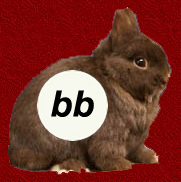 X
X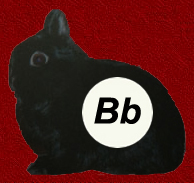
sire (chocolate) dam (black)

offspring (chocolate)
Until
the chocolate
youngster was produced it wasn't
knownthat the
doe carries a brown b
gene allele recessively. Although
we anticipated the
offspring inheriting one chocolate
b
allele from its sire (who had nothing else to transmit), we now know
that the
second b allele came from its
mother as the rabbit inherits one b-allele from each parent.
The odds were 50/50 that the dam would transmit her dominant black B
allele, resulting in a black rabbit.
If that had happened, we wouldn't
have discovered that the Black doe is
carrying a b allele.
Intense
D and Dilute d
The blue and lilac colours are controlled by the d-series. The d-series is referred to as dilution. What dilution does is to change black to blue, and to change chocolate to lilac. It also changes brown eyes to grey eyes. (It changes orange to fawn in varieties which have orange colour in the coat). There are only two alleles in the d-series: D and d.
D =
intense
d = dilute
The dominant intense D
allele has no effect on
black or brown colour. However,
the recessive dilute d allele changed
black to blue, or brown to lilac, whenever it is inherited
in
two pairs by the rabbit. (two dilute dd alleles). In other words, the
rabbit
must receive one recessive dilute d
gene allele from its sire and one recessive dilute d gene from its dam, making the resulting rabbits'
genotype
dd, before the action of dilution can occur.
Therefore, a basic black rabbit (who can be either BB
or Bb), who inherits two recessive dilution
dd alleles will be changed into a
basic blue rabbit. A basic brown
rabbit (who is always bb) who inherits
a pair of recessive dilution dd gene
alleles will be changed into a basic lilac rabbit
Here's
an example of breeding two
Dwarf rabbits to see how dilution changes black to blue and brown to
lilac.
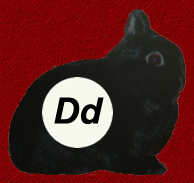 X
X 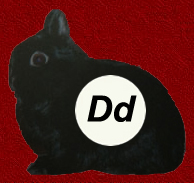
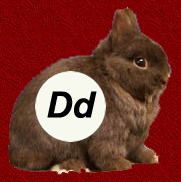 X
X 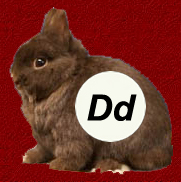
Sire (black) Dam (black) Sire (chocolate) Dam (chocolate)
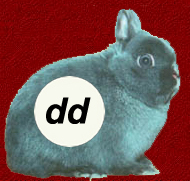
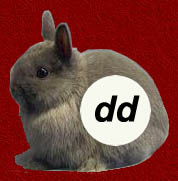
offspring (blue) offspring (lilac)
We have produced a Blue youngster from our pair of Blacks. Upon the appearance of this Blue, we have learned that both the Black sire and the Black dam are carrying one dilute d allele recessively to their dominant intense D. Although we couldn't determine this by observing their phenotype, their production of a Blue offspring proves what their genotype is. Even though our Blue bunny comes from a pair of Black parents, it did not happen to inherit a dominant intense D allele from either parent. We have also produced a lilac from our pair of Chocolates, which proves both the chocolate sire and the chocolate dam are carrying one dilute d allele recessively.
When the two dilute dd gene alleles are inherited, all colour on the rabbit is diluted, including every hair and including its iris colour. All varieties have an intense and a dilute counterpart. In some cases both the intense and dilute varieties are recognised though there are some varieties in which neither the intense nor the dilute state is recognised (such as in the Chocolate Chinchilla and Lilac Chincilla).
colour distribution in the fur shaft
non - extension in the fur shaft